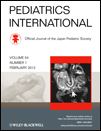Association of adrenergic receptor gene polymorphisms with adolescent obesity in Taiwan
Abstract
Background: Polymorphisms of β2-adrenergic receptor (ADRB2) and β3-adrenergic receptor (ADRB3) have been reported to be associated with obesity in adults and adolescents, although study results have been controversial. The aim of the present study was to investigate the association of polymorphisms of ADRB2 (Arg16Gly, Gln27Glu) and ADRB3 (Trp64Arg) with adolescent obesity in Taiwan.
Methods: A total of 559 adolescent volunteers with equal numbers female and male were enrolled. Participants were divided into two groups: obese (body mass index [BMI]≥ 95th percentile) and normal weight (BMI 15th–85th percentile). Genomic DNA was extracted from buccal mucosa cells and genotyped in TaqMan assays. Genotype results and clinical subject characteristics were analyzed.
Results: Among the three ADRB polymorphisms, only Arg16Gly polymorphism was found to be significantly correlated with adolescent obesity, especially in girls. Girls with genotype Gly/Gly had a lower probability of obesity than those with genotypes Arg/Gly or Arg/Arg (P= 0.006; Arg/Gly: odds ratio [OR], 2.57, 95% confidence interval [95%CI]: 1.22–5.41; Arg/Arg: OR, 3.03, 95%CI: 1.50–6.12). Girls with genotype Gly/Gly had lower BMI than those with genotype Arg/Arg (P= 0.049). Obese adolescents with genotype Gly/Gly had a lower probability of hypertension than those with genotype Arg/Gly or Arg/Arg (P= 0.005).
Conclusions: Arg16Gly polymorphism of ADRB2 was significantly associated with obesity in female adolescents, and those with the Gly/Gly genotype were associated with a lower possibility of obesity and lower BMI. This polymorphism was also associated with a lower probability of hypertension in obese adolescents. The other two polymorphisms of ADRB (Gln27Glu and Trp64Arg) were not associated with adolescent obesity in Taiwan.




